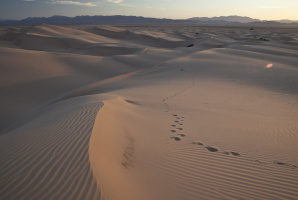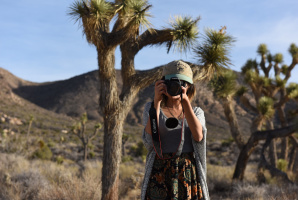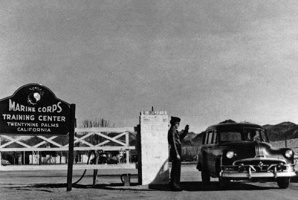Homesteading
What’s Up With All Those Cabins?
Five Acres of Heaven
by Ed Ainsworth
The original intent of the Homestead Act passed in 1862 during the first Presidential term of Abraham Lincoln was granting agricultural homesteads of 160 or 320 acres.
Paul Witmer, who took over the Office of Land Management in Los Angeles in the early 1930s, knew little of the great arid area and was puzzled about the fact that desert dwellers around Twentynine Palms had taken up homesteads. Many of them were veterans. Why would anyone want to try to farm in the desert?
So he decided to see for himself and made the difficult 150-mile journey from Los Angeles by car. When he arrived in Twentynine Palms, he saw the water hole and the famous clump of native palms which had given the spot its name and which for many years had been a meeting place for Indians.
 Scattered around the oasis for miles in almost every direction were the scraggly homesteads of the settlers. Witmer was astounded. He saw the almost complete lack of crops, but he found a race of hardy, happy people who gloried in their isolated surroundings and valued a sunset more than money and health, more than the conveniences of city life. They told him their stories. He became convinced that the desert offered unlimited possibilities for saving sick people—not only physically, but also in restoring their mental and spiritual confidence. Plenty of proof was available.
Scattered around the oasis for miles in almost every direction were the scraggly homesteads of the settlers. Witmer was astounded. He saw the almost complete lack of crops, but he found a race of hardy, happy people who gloried in their isolated surroundings and valued a sunset more than money and health, more than the conveniences of city life. They told him their stories. He became convinced that the desert offered unlimited possibilities for saving sick people—not only physically, but also in restoring their mental and spiritual confidence. Plenty of proof was available.
Bill Underhill, one of the veterans, was so enthusiastic that he took Witmer around to meet a lot of the “boys,” the veterans who were subsisting on their pension checks. The local school teacher said that even though her complexion sometimes suffered from the dry desert wind she was more than compensated by seeing her pupils, many of whom were incapacitated with asthma when they arrived, playing football and running foot races within three weeks.
Witmer got as fired up as a Billy Sunday convert. He drove back to Los Angeles determined to spread the gospel of desert health and to make it easier for veterans and just ordinary people to get a foothold in the healing desert.
The big disadvantage was the nature of the Homestead Act. Nobody needed 160 acres where there was inadequate water and where the soil wasn’t suited for farming. Witmer was convinced that what was needed was a small homestead at an extremely low price, so more people could take advantage of its opportunities.
Witmer knew how slow the Federal government was to absorb new ideas, so he sought help in arousing public opinion. One of the people he went to was Harry Carr, a famous columnist of the Los Angeles Times, whose “Lancer” spoke out in favor of, or against, all sorts of things. He received enthusiastic response from the start and Harry Carr started writing.
Witmer got a bill drawn up providing for “baby homesteads” of five acres for health purposes to be paid for at the rate of $10 an acre. The irascible Secretary of the Interior, Harold L. Ickes, frowned his well-known frown and the bill died a-borning. The second attempt in 1937 met defeat.
Witmer and his allies refused to be daunted; they were trying to make it succeed not only on its own merits but as a memorial to Harry Carr; the great columnist had died but his passionate interest in the project was an obligation on them to carry it through. The third bill was introduced. In 1938 the Five Acre Tract bill passed and became law.
[Excerpt from “Five Acres of Heaven” by Ed Ainsworth, author and former columnist for Los Angeles Times; published by Col. E. B. Moore in 1955.]
Homestead Cabins
The Homestead Act – 1862
A homesteader had only to be the head of a household or at least 21 years of age to claim a 160-acre parcel of land. Settlers from all walks of life including newly arrived immigrants, farmers without land of their own from the East, single women and former slaves came to meet the challenge of “proving up” and keeping this “free land.” Each homesteader had to live on the land, build a home, make improvements, and farm for 5 years before they were eligible to “prove up.” A total filing fee of $18 was the only money required, but sacrifice and hard work exacted a different price from the hopeful settlers.
The Homestead Act remained in effect until it was repealed in 1976, with provisions for homesteading in Alaska until 1986. Under the Homestead Act, 270 million acres of land, or 10% of the nation, was given away. The only monetary payment for each 160-acre claim was an $18 filing fee.
The Small Tract Act – 1938
Col. E. B. Moore was an early realtor and promoter of five-acre “jackrabbit” homesteads. The desert was opened to five-acre homesteads by the 1938 Small Tract Act, which made available former Bureau of Land Management (BLM) land throughout the Mojave Desert, although the land rush did not start until the 1950s. Moore was said to have helped some 10,000 people file on the homesteads for as little as $10 an acre.
10×12 Cabins
In addition to veteran homesteaders after World War I, the Great Depression drove many brave souls to live in the Mojave Desert. “They too had to meet the requirements of homesteading by constructing a cabin, at least 10 x 12 feet (120 sq.ft.), and like the pioneers of the Great Plains before them, turned to nature to provide the building material. By mixing the clay from the dry lakes with sand and water, they could make sun-dried bricks.”The Small Tract Act of 1938 was a boon for desert homesteaders in the Twentynine Palms area. “The tracts, which were referred to as ‘Baby Homesteads’ or Jackrabbit Tracts, were not to exceed five acres of public land which were classified chiefly valuable as home, cabin, camp for health, convalescent, recreational, or business use.“It was not until the end of World War II that interest was shown in these properties. Gas and tire rationing were lifted and Route 62 had been blacktopped. In the Morongo Basin there was a population explosion of weekenders, mainly from the Los Angeles area. By the mid-1950s, the Bureau of Land Management was receiving 100 applications a day for free land; and by 1960, was obliged to impose an 18-month moratorium on public filing in order to process the backlog of nearly 60,000 applications.”
[Excerpt from American Desert Magazine, Nov. 1992, article by Pat Rimmington, author of The Adobes of Twentynine Palms, 1988 and 2009.]
Jackrabbit Homestead
 An exploration of the cabins that dot the landscape in Twentynine Palms and Wonder Valley can be found in author Kim Stringfellow’s Jackrabbit Homestead 2009 book and web-based multi-media presentation and car audio tour. “…Although jackrabbit homesteading occurred sporadically throughout the United States beginning in the 1940s, it proved most popular in Alaska and the far Western states, especially in the Morongo Basin area near Twentynine Palms. The Los Angeles Times called the phenomena ‘one of the strangest land rushes in Southern California history.’ Hundreds of applicants flooded regional land offices managed by the Bureau of Land Management (BLM) after reading how simple it was to file a claim. Still, jackrabbit homesteading did not take off until the end of World War II when building materials again became readily available and gas and tire rationing had ended.”
An exploration of the cabins that dot the landscape in Twentynine Palms and Wonder Valley can be found in author Kim Stringfellow’s Jackrabbit Homestead 2009 book and web-based multi-media presentation and car audio tour. “…Although jackrabbit homesteading occurred sporadically throughout the United States beginning in the 1940s, it proved most popular in Alaska and the far Western states, especially in the Morongo Basin area near Twentynine Palms. The Los Angeles Times called the phenomena ‘one of the strangest land rushes in Southern California history.’ Hundreds of applicants flooded regional land offices managed by the Bureau of Land Management (BLM) after reading how simple it was to file a claim. Still, jackrabbit homesteading did not take off until the end of World War II when building materials again became readily available and gas and tire rationing had ended.”
[Excerpt from Kim Stringfellow’s website: www.jackrabbithomestead.com]
[Photo top right © Kim Stringfellow 2009 – 2018]
[Amboy Mailboxes, digital photo art by Steve Flock, Twentynine Palms, CA.]
[Red Cabin, digital photo art by Steve Flock, Twentynine Palms, CA.]
[Photo of Col. E.B. Moore sales booth on Highway 62 from “Images of America: Twentynine Palms,” Arcadia Publishing, 2007.]
Celebrities
Stars of the Past in 29 Palms. MGM movie actress and American swimming star Esther…
Historic Buildings & Adobes
Little Church of the Desert, a longtime landmark in downtown Twentynine Palms, was dedicated on November 6…
Marine Corps Base
In 1952, Lt. Col. Frederick H. Scantling brought a detachment of two dozen Marines from Camp Pendleton…




